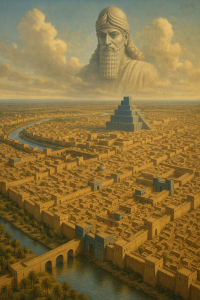 Marduk: Founder of Babylon, the Sacred Center
Marduk: Founder of Babylon, the Sacred Center
“They built for him a princely shrine, a lofty abode. He established Babylon, made it the dwelling of the great gods, and called it by name.”
(Enuma Elish, Tablet VI)
After ordering the cosmos and setting the gods in their stations, Marduk turned to the earth and placed his mark upon it. He did not claim every land, nor every mountain—he chose one place: Babylon. There, at the confluence of rivers and beneath the pattern of the stars, he established his shrine and made it the gathering point of the divine assembly.
Babylon is not simply a city. It is the axis mundi—the meeting of heaven and earth, law and manifestation, time and eternity. From its ziggurat rose the path to the divine realm. Through its streets flowed the echoes of the celestial order. To walk its boundaries was to walk within sacred architecture.
To found a city is to declare meaning upon the land. It is to fix orientation, draw boundaries, and root one’s will into the earth. Marduk’s founding of Babylon reveals that sacred space is never accidental. It is made by intent, sanctified by presence, and upheld by ritual and law.
Today, contemplate your own center. Where is your Babylon? Where do your thoughts return, your power gather, your inner temple rise? Have you established any fixed place in your life where order is upheld and the divine is honored?
To emulate Marduk is to build deliberately. It is to choose a ground, mark it, and dedicate it. This may be a room, a practice, a moment in the day—but it must be real, and it must be maintained. Without a center, even the strong become scattered.
Babylon is not only a city on a map—it is the structure of alignment rooted into the soil of time.
